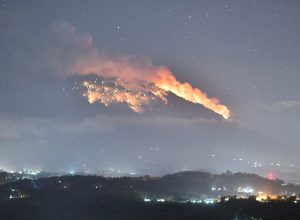
By Kanupriya Kapoor and Slamet Kurniawan
KARANGASEM, Indonesia (Reuters) – Indonesia kept the airport on Bali closed on Tuesday as ash from an erupting volcano swept the holiday island, leaving thousands of tourists stranded as authorities tried to persuade villagers living nearby to leave their homes.
A total of 443 flights, both domestic and international, were affected by the closure of the airport, about 60 km (37 miles) from Mount Agung which is spewing smoke and ash high into the sky.
“Aircraft flight channels are covered with volcanic ash,” the transport ministry said in a statement, citing aviation navigation authorities.
The airport – the second-biggest in Indonesia – will be closed at least until 7 a.m. on Wednesday (2300 GMT on Tuesday), the ministry said.
Frustration at the airport was starting to boil over, with an estimated 2,000 people attempting to get refunds and reschedule tickets.
“There are thousands of people stranded here at the airport,” said Nitin Sheth, a tourist from India. “They have to go to some other airport and they are trying to do that, but the government or authorities here are not helping.”
Others were more relaxed.
“No, there’s not a lot of information … very little. (But) it’s all right. We’re on holidays so it doesn’t matter. We don’t know what’s going to happen but we can get back to the bar and have another drink,” said Matthew Radix from Perth.
The airport operator said 201 international flights and 242 domestic ones had been hit.
Ten alternative airports had been prepared for airlines to divert inbound flights, including in neighboring provinces, the operator said, adding it was helping people make alternative bookings and helping stranded travelers.
The airport on Lombok island, to the east of Bali, had reopened, authorities said, as wind blew ash westward, towards the southern coast of Java island.
PRAYERS
Agung towers over eastern Bali to a height of just over 3,000 meters (9,800 feet). Its last eruption in 1963 killed more than 1,000 people and razed several villages.
On Tuesday, however, life went on largely as normal in surrounding villages, with residents offering prayers as the volcano sent huge billows of ash and smoke into the sky.
Some villagers who fled in September, when the alert was last raised to the highest level, have gone home despite government warnings.
On Monday, authorities said 100,000 residents living near the volcano had been ordered to get out of an 8-10 km (5-6 mile) exclusion zone, warning a larger eruption was “imminent”.
While the population in the area has been estimated at anywhere between 63,000 and 140,000, just over 29,000 people were registered at emergency centers, said Sutopo Purwo Nugroho, a spokesman for the Disaster Mitigation Agency.
“Not all people in the danger zone are prepared to take refuge,” he said.
“There are still a lot of residents staying in their homes.”
Indonesia’s Volcanology and Geological Disaster Mitigation Center has warned that an eruption of a size similar to that seen in 1963 could send rocks bigger than a fist flying a distance of up to 8 km (5 miles), and volcanic gas a distance of 10 km (6 miles) within three minutes.
Monitoring has shown the northeastern part of Agung’s peak had swollen in recent weeks “indicating there is fairly strong pressure toward the surface”, the center said.
For interactive package on Agung eruptions, click: http://tmsnrt.rs/2hYdHiq
For graphic on the Pacific Ring of Fire, click: http://tmsnrt.rs/2BjtH6l
(Reporting by Kanupriya Kapoor, Slamet Kurniawan, Nyimas Laula and Reuters Bali stringer in BALI, and; Bernadette Christina Munthe, Cindy Silviana and Fransiska Nangoy in JAKARTA; Additional reporting by Angie Teo and Ed Davies; Writing by Fergus Jensen; Editing by Michael Perry, Robert Birsel)




